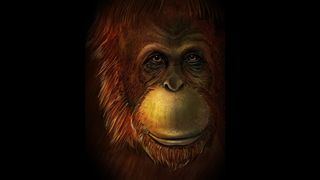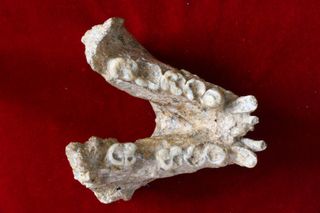Closest Living Relative of Extinct 'Bigfoot' Found
The massive, extinct primate was twice as tall as an adult human.

The mythical and elusive "Bigfoot" is a creature of legend, but for millions of years, the original Bigfoot — a shaggy, bipedal ape twice the size of an adult human — roamed the forests of Southeast Asia, before going extinct hundreds of thousands of years ago.
Scientists are now developing a clearer picture of the giant animal's place on the primate family tree, after conducting groundbreaking analysis of proteins in tooth enamel dating to nearly 2 million years ago.
Gigantopithecus blacki dwarfed the great apes that live today; it stood around 10 feet (3 meters) tall and weighed up to 595 lbs. (270 kilograms). But as massive as Gigantopithecus was in life, fossils of the hefty primate have been few and hard to find — thousands of teeth and four partial jaws — leaving many questions about the extinct ape's evolutionary lineage and appearance.
Related: Kind of a Big Deal: How King Kong Measures Up (Images)
Genetic analysis of fossils can provide important clues about long-extinct animals, but in very old fossils from warm, humid geographic regions, the DNA is usually too degraded to be of much use. For example, in subtropical Asia where Gigantopithecus lived, the only viable DNA previously obtained came from other animals' fossils that were no more than 10,000 years years old, according to a new study, published online today (Nov. 13) in the journal Nature.
However, the study authors had recently devised a new method for recovering and reconstructing protein sequences from dental enamel, and they tested this technique on a Gigantopithecus molar dating to 1.9 million years ago. They then compared what they found to a database of protein sequences from great apes alive today.
"What we observed is the number of differences in the sequences," said lead study author Enrico Cappellini, an associate professor at the University of Copenhagen. "We assume that the lower the number of differences, the closer the two species are related, and the later they diverged," Cappellini told Live Science.
Sign up for the Live Science daily newsletter now
Get the world’s most fascinating discoveries delivered straight to your inbox.

They found that the extinct "Bigfoot" isn't a close human relative, like chimpanzees and bonobos. Rather, the sequences that most resembled Gigantopithecus proteins belonged to modern orangutans, and the giant ape's lineage is thought to have split from its cousin's around 12 million to 10 million years ago, the scientists wrote in the study. The success of their method raises intriguing possibilities for investigating protein sequences in other extinct primates from tropical areas — "namely, extinct species more closely associated with our own evolutionary lineage," Cappellini said.
In reconstructions, Gigantopithecus often resembles an oversize orangutan; in the past, these artistic representations have been based on limited information from the fossils and from what was known about the primate's range and ancient habitat, Cappellini said. But even though the new evidence confirms a close evolutionary relationship between Gigantopithecus and orangutans, the data can't tell scientists what the extinct ape may have looked like, Cappellini added.
"The information we retrieved can't say anything about appearance, phenotype or biology," Cappellini explained. "There's no evidence for that."
- 6 Extinct Animals That Could Be Brought Back to Life
- In Photos: A Game-Changing Primate Discovery
- In Photos: Adorable Orangutan Shows Off Knot-Tying Skills
- The most famous Bigfoot sightings
Originally published on Live Science.


Mindy Weisberger is an editor at Scholastic and a former Live Science channel editor and senior writer. She has reported on general science, covering climate change, paleontology, biology and space. Mindy studied film at Columbia University; prior to Live Science she produced, wrote and directed media for the American Museum of Natural History in New York City. Her videos about dinosaurs, astrophysics, biodiversity and evolution appear in museums and science centers worldwide, earning awards such as the CINE Golden Eagle and the Communicator Award of Excellence. Her writing has also appeared in Scientific American, The Washington Post and How It Works Magazine. Her book "Rise of the Zombie Bugs: The Surprising Science of Parasitic Mind Control" will be published in spring 2025 by Johns Hopkins University Press.